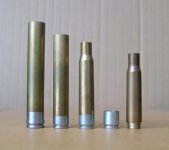This may just be a passing fancy, but I thought of a number of problems I could solve if I could make my own cases. I've heard about making steel heads for existing brass cases, and this technique would address everything I'm interested in too.
Anybody know of an "instruction" source (internet or print)? Also, the pluses and minuses of steelheads, aside from the amount of work involved?
TIA
Charles
Hi Charles,
I used to shoot with a guy, decades ago, that made his own steel head cases for his 1000 yard competition rifle in 30-06, which would chrono to maximum 300 Winchester Mag. velocities. Very impressive and accurate for the amount of powder and recoil.
If I remember correctly, he started out by purchasing his steel heads from a company called Ramshot or some such, back in Indiana, which subsequently disappeard, so he started making his own out of both 12L14 and 416 stainless round stock.
After awhile he began making the entire cases out of steel in 2 separate pieces, the head and the body-shoulder-neck, which were threaded to each other.
The most impressive thing about the all steel cases is that they required no sizing after firing, due to not exceeding the elasticity limits of steel and staying within the rebound capabilities of the material.......... just re-prime, re-powder, and seat a new bullet. Also, the cases lasted forever, he would make 20 for the rifle and that was all that was ever needed for that caliber case.
I do remember him saying that he prefered to use boat tail bullets in the all steel cases because the steel necks had a tendency to shave the heel of a flat base bullet and caused subsequent inaccuracy. I think he also stated the steel necks had to be considerably thinner than brass necks in order to get proper release properties.
The only limitations in the velocities that he could run in the rifles that used steel cases were the primers when they would start to blank. And, this was well before the small firing pin diameter fad, which I am sure would have increased the velocity capabilities considerably................Don


